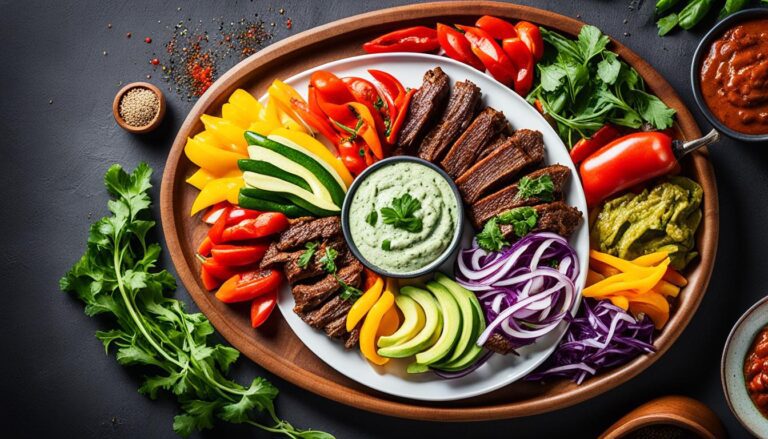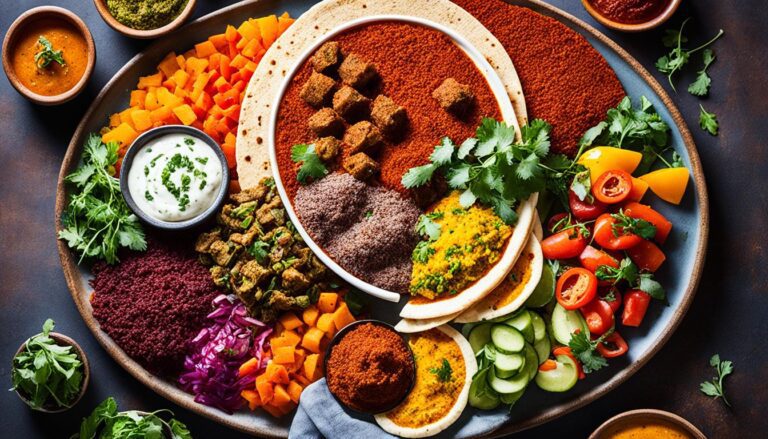What Is Ethiopian Food Made Of?
When it comes to delicious and exotic cuisines, Ethiopian food is sure to stand out. But have you ever wondered what ingredients go into creating these flavorful dishes? From bold spices to unique grains, Ethiopian cuisine is a culinary adventure full of surprises.
A History of Ethiopian Cuisine
Ethiopian cuisine has a rich history that spans centuries. Throughout its evolution, the region of modern-day Ethiopia has been influenced by a variety of exotic spices and indigenous grains that have shaped its unique culinary traditions.
In the 1400s, Ethiopia became a hub for international trade, attracting the arrival of spices from India, such as cardamom and coriander, as well as ginger from East Asian countries and chile peppers from Portugal. These spices, along with other introduced ingredients, became integral to Ethiopian cuisine, adding depth and complexity to its flavors.
One of the defining features of Ethiopian cuisine is the use of indigenous grains, including sorghum, millet, teff, and wheat. These grains thrived in the temperate climate of the region and became staple ingredients in Ethiopian dishes. Teff, in particular, holds a significant place as the primary ingredient used in making injera, a sour fermented bread that serves as the foundation for many Ethiopian meals.
Today, Ethiopian cuisine is a harmonious blend of exotic spices and indigenous grains. It embraces the rich history and diverse cultural influences that have shaped the country’s culinary heritage. By incorporating flavors from around the world and utilizing locally-sourced ingredients, Ethiopian dishes continue to captivate taste buds with their distinctive and vibrant profiles.
Stay tuned for Section 3 where we explore the distinct flavors of Ethiopian food!
The Distinct Flavors of Ethiopian Food
Ethiopian food is a culinary delight that entices the taste buds with its unique and distinct flavors. The combination of spices, herbs, and ingredients creates a flavor profile that is both bold and diverse. At the heart of Ethiopian cuisine are the rich and vibrant flavors that come from a blend of earthy, spicy, tart, sour, and pungent tastes.
The star of many Ethiopian dishes is the spice blend called Berbere, which adds depth, complexity, and a touch of heat to the flavors. Berbere typically includes a combination of chile peppers, fenugreek, cinnamon, ginger, cardamom, and coriander. This aromatic blend infuses dishes with a robust and tantalizing flavor that is truly unique to Ethiopian cuisine.
The flavors of Ethiopian food are further enhanced by the use of fresh herbs and unique ingredients. The tartness of lime, the sharpness of garlic, and the earthiness of cumin all contribute to the rich and aromatic taste experience. Each bite is a delightful journey through a combination of flavors that makes Ethiopian food a true culinary adventure.
Traditional Ethiopian Dishes You Need to Know

Ethiopian cuisine offers a wide variety of traditional dishes that showcase the diverse flavors and ingredients of Ethiopian food. These dishes are an integral part of Ethiopian culture and provide a delightful culinary experience.
One popular traditional Ethiopian dish is tibs, a delicious beef dish sautéed with onions, garlic, and a flavorful blend of Ethiopian spices known as Berbere. The combination of tender beef and aromatic seasonings creates a mouthwatering dish that is often served with the traditional Ethiopian sour bread, injera.
Another must-try dish is shiro be kibbe, a saucy legume or lentil stew made with ground split peas, chickpeas, and spiced butter. This hearty dish is packed with flavors and is often enjoyed as a vegetarian option in Ethiopian cuisine.
For those who enjoy unique flavors, kitfo is a standout dish. Kitfo is an Ethiopian beef tartare that is made with finely ground raw beef mixed with a spiced butter known as niter kibbeh. This bold and flavorful dish is typically served with injera and offers a truly unique culinary experience.
Other traditional Ethiopian dishes worth trying include doro wat, a spiced chicken stew, injera firfir, a dish made with torn pieces of injera mixed with spices and sautéed with meat or vegetables, and key wat, a slow-cooked beef stew that is full of rich and comforting flavors.
These traditional Ethiopian dishes are a true representation of the country’s culinary tradition and offer a taste of the exotic flavors and ingredients that make Ethiopian cuisine so special.
How Ethiopian Food is Eaten

When it comes to experiencing Ethiopian cuisine, the way it is eaten is just as important as the flavors themselves. At the heart of Ethiopian dining is the use of injera, a sour fermented teff flour bread that serves as a foundation for the meal. Injera is often rolled into a large flatbread, ready to be loaded with a variety of delicious dishes.
What makes Ethiopian dining truly special is its communal nature. Picture a large circular tray of injera, beautifully arranged with an assortment of vibrant dishes. This tray becomes the centerpiece of the meal, drawing everyone together to share in the experience.
Unlike traditional Western dining, Ethiopian food is enjoyed without the use of utensils. Instead, we use our hands to tear off a piece of injera and use it to scoop up a bite-sized portion of food. The combination of injera and the various dishes creates a harmonious blend of flavors and textures, making each bite a delightful adventure.
This hand-eating style of dining is not only practical but also symbolic of the communal aspect of Ethiopian culture. The act of sharing a meal with loved ones, using our hands to connect with the food, creates a sense of unity and togetherness.
So, the next time you indulge in Ethiopian cuisine, embrace the cultural experience of hand-eating and savor the flavors that come alive when injera and the vibrant dishes join forces. It’s a truly unique and communal way to enjoy the rich culinary tradition of Ethiopian food.
Conclusion
Ethiopian cuisine offers a culinary journey filled with rich flavors and unique ingredients. From the history of Ethiopian food to the distinct taste profile created by a blend of spices and herbs, Ethiopian cuisine has gained popularity worldwide. Traditional Ethiopian dishes like tibs, shiro be kibbe, and kitfo showcase the diverse flavors and ingredients that make Ethiopian food special.
The communal style of dining, with injera as the base, adds to the cultural experience of Ethiopian cuisine. Sharing a meal around a communal tray of injera loaded with flavorful dishes brings people together and fosters a sense of community. This style of dining also reflects the importance of hospitality in Ethiopian culture.
Exploring Ethiopian food is not only a delight for the taste buds but also an opportunity to immerse ourselves in the culinary tradition of a remarkable country. Whether it’s the spicy kick of berbere seasoning or the tangy flavors of injera, Ethiopian food never fails to surprise and satisfy. So, next time you’re looking to try something new and exciting, don’t hesitate to indulge in the flavors and traditions of Ethiopian cuisine.







